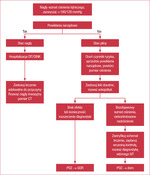Piśmiennictwo
1. Zdrojewski Ł, Zdrojewski T, Rutkowski M, et al. Prevalence of chronic kidney disease in a representative sample of the Polish population: results of the NATPOL 2011 survey. Nephrol Dial Transpl 2016;31:433-9.
2. Sgueglia GA, Varounis C. Cardiovascular Hypertensive Crisis: Recent evidence and Review of the Literature. Front Cardiovasc Med 2017;3:1-5.
3. Brokmann JC, Rossaint R, Müller M, et al. Blood pressure management and guideline adherence in hypertensive emergencies and urgencies: A comparison between telemedically supported and conventional out-of-hospital care. J Clin Hypertens 2017;19:704-12.
4. Mancia G, Fagard R, Narkiewicz K, et al. 2013 ESH/ESC Guidelines for the management of arterial hypertension. Blood Press 2013;22:193-278.
5. Vaughan CJ, Delanty N. Hypertensive emergencies. Lancet 2000;356:411-7.
6. Kaplan NM, Victor RG. Hypertensive urgencies. In: Kaplan’s Clinical Hypertension: Eleventh Edition 2015:263-74.
7. Elliott WJ, Rehman SU, Vidt DG, et al. Hypertensive Emergencies and Urgencies. In: Hypertension: A Companion to Braunwald’s Heart Disease: Second Edition 2012:390-5.
8. Kawazoe N, Onoyama K, Abe I, et al. Pathophysiology in malignant hypertension: With special reference to the renin angiotensin system. Clin Cardiol 1987;10:513-8.
9. Raven PB, Fadel PJ, Ogoh S. Arterial baroreflex resetting during exercise: a current perspective. Exp Physiol 2006;91: 37-49.
10. Lagi A, Cencetti S. Hypertensive emergencies: a new clinical approach. Clin Hypertens 2015;21:1-7.
11. Theodoropoulou A, Metallinos IC, Elloul J, et al. Prolactin, cortisol secretion and thyroid function in patients with stroke of mild severity. Horm Metab Res 2006;38:587-91.
12. Zuber SM, Kantorovich V, Pacak K. Hypertension in pheochromocytoma: Characteristics and treatment. Endocrinology and Metabolism Clinics of North America 2011;40:295-311.
13. Amraoui F, van Montfrans G a, van den Born BJH. Value of retinal examination in hypertensive encephalopathy. J Hum Hypertens 2010;24:274-9.
14. Saguner AM, Dur S, Perrig M, et al. Risk factors promoting hypertensive crises: evidence from a longitudinal study. Am J Hypertens 2010;23:775-80.
15. Katz JN, Gore JM, Amin A, et al. Practice patterns, outcomes, and end-organ dysfunction for patients with acute severe hypertension: The Studying the Treatment of Acute hyperTension (STAT) Registry. Am Heart J 2009;158:599-606.
16. Grassi D, O’Flaherty M, Pellizzari M, et al. Hypertensive urgencies in the emergency department: Evaluating blood pressure response to rest and to antihypertensive drugs with different profiles. J Clin Hypertens 2008;10:662-7.
17. Zampaglione B, Pascale C, Marchisio M, et al. Hypertensive urgencies and emergencies. Prevalence and clinical presentation. Hypertension 1996;27: 144-7.
18. Van Den Born BJH, Honnebier UPF, Koopmans RP, et al. Microangiopathic hemolysis and renal failure in malignant hypertension. Hypertension 2005;45:246-51.
19. Shavit L, Reinus C, Slotki I. Severe renal failure and microangiopathic hemolysis induced by malignant hypertension – case series and review of literature. Clin Nephrol 2010;73:147-52.
20. Trivelli A, Ghiggeri GM, Canepa A, et al. Hyponatremic-hypertensive syndrome with extensive and reversible renal defects. Pediatr Nephrol 2005;20:102-4.
21. Kennedy L. Hypertensive emergency. In: Problem solving in hypertension Clinical Publishing, Oxford 2009:143-8.
22. Węgrzyn A, Targoński R, Bellwon J i wsp. Leczenie nadciśnienia tętniczego ze wskazań doraźnych. Część I. Stany pilne. Nadciśnienie Tętnicze 2004;8:133-8.
23. Patel KK, Young L, Howell EH, et al. Characteristics and Outcomes of Patients Presenting With Hypertensive Urgency in the Office Setting. JAMA Intern Med 2016;176:981.
24. Cuspidi C. Stany pilne i nagłe w nadciśnieniu tętniczym. W: Mancia G, Grassi G, Kjeldsen SE. Nadciśnienie tętnicze. Podręcznik European Society of Hypertension 2009:307-14.
25. Ponikowski P, Voors AA, Anker SD, et al. 2016 ESC Guidelines for the diagnosis and treatment of acute and chronic heart failure. Eur Heart J 2016;37: 2129-200.
26. Roffi M, Patrono C, Collet J-P, et al. 2015 ESC Guidelines for the management of acute coronary syndromes in patients presenting without persistent ST-segment elevation. Eur Heart J [Internet] 2016;37:267-315.
27. Ibanez B, James S, Agewall S, et al. 2017 ESC Guidelines for the management of acute myocardial infarction in patients presenting with ST-segment elevation. Eur Heart J 2017;38:1-66.
28. Erbel R, Aboyans V, Boileau C, et al. 2014 ESC Guidelines on the diagnosis and treatment of aortic diseases. Eur Heart J 2014;35:2873-926.
29. Nienaber CA, Clough RE. Management of acute aortic dissection. The Lancet 2015;385:800-11.
30. Appleton JP, Sprigg N, Bath PM. Blood pressure management in acute stroke. Stroke Vasc Neurol 2016;1:72-82.
31. Adams HP, Bruno A, Connors JJB, et al. AHA/ASA Guideline Guidelines for the Early Management of Patients With Acute Ischemic Stroke. Stroke 2013;44:870-947.
32. Iii JCH, Greenberg SM, Cushman M, et al. AHA/ASA Guideline Guidelines for the Management of Spontaneous Intracerebral Hemorrhage A Guideline for Healthcare Professionals From the American Heart. Stroke 2015;46:2032-60.
33. Committee on Obstetric Practice. Committee Opinion No. 623: Emergent therapy for acute-onset, severe hypertension during pregnancy and the postpartum period. Obstet Gynecol [Internet] 2015;125:521-5.
34. Gauer R, Army W, Bragg F, et al. Severe Asymptomatic Hypertension: Evaluation and Treatment. Am Fam Physician 2017;15:492-500.
35. Olszanecka A, Klocek M. Przełom nadciśnieniowy – postępowanie na izbie przyjęć. Med Dypl 2016;25(1):16-26.
